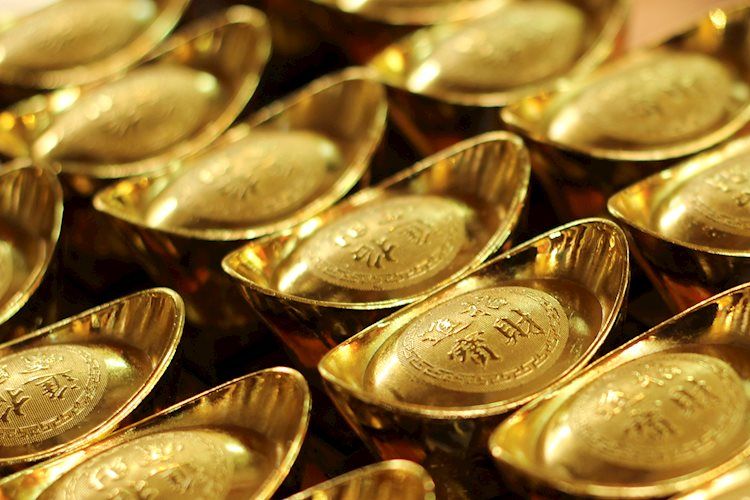Jobs
Gold price turns red amid the renewed US dollar demand

- Gold price trades in negative territory on Tuesday amid the renewed USD demand.
- A downbeat US jobs data for April prompted speculation of potential rate cuts by the Fed in the coming months.
- Investors will keep an eye on Fed’s Kashkari’s speech later on Tuesday.
Gold price (XAU/USD) loses its recovery momentum on Tuesday. The downtick of the yellow metal is supported by the renewed US Dollar (USD) demand. However, the recent US Nonfarm Payrolls (NFP) data has boosted bets that the Federal Reserve (Fed) would cut interest rates later this year. The expectation of an easing cycle might lift the gold price as it makes gold a cheaper option for foreign buyers to purchase. Furthermore, strong central bank purchases and demand from Asian markets remain to support the precious metal in the near term.
On the other hand, the signs of ongoing political tensions in the Middle East might boost the safe-haven flows and benefit the gold price. Fed Bank of Minneapolis President, Neel Kashkari, is scheduled to speak later on Tuesday. The hawkish tone from the Fed officials might support the USD and weigh on the USD-denominated gold.
Daily Digest Market Movers: Gold price remains strong amid inflationary environment and uncertainty
- Richmond Fed President Thomas Barkin said that the current interest rate level should cool the economy enough to bring down inflation to the 2% target, with the strength of the job market giving officials time to gain confidence that inflation will fall.
- New York Fed President John Williams stated that there would be rate cuts eventually. Williams further stated that he is seeing job growth moderating and the Fed is looking at the “totality” of data.
- Markets have priced in rate cuts worth 46 basis points (bps) from the Fed by the end of 2024, with the first cut expected in September or November, according to LSEG’s rate probability app.
- Hamas announced its acceptance of an Egyptian-Qatari cease-fire plan on Monday. However, Israel turned down the deal since it did not fulfill its “core demands” and continued its attack on Rafah in southern Gaza. Still, Israel said that it will continue negotiating, per Reuters.
- Gold has advanced about 12% this year despite the elevated inflationary environment and uncertainty over when the US Fed will cut rates.
- The US employment data showed job growth in the US slowed more than expected in April, while the increase in annual wages fell below 4.0% for the first time in nearly three years.
Technical Analysis: Gold price seems poised to consolidate further in the near term
Gold price trades on a negative note on the day. The yellow metal maintains the constructive outlook unchanged, as XAU/USD is above the key 100-day Exponential Moving Average (EMA) on the daily timeframe.
In the shorter term, the gold price has remained confined within a descending trend channel since mid-April. Nonetheless, the path of least resistance is to the upside as the 14-day Relative Strength Index (RSI) holds in the bullish territory around 58.0.
The confluence of the upper boundary of a descending trend channel and a high of April 26 in the $2,350–$2,355 zone will be the first upside target for the precious metal. Further north, the next barrier will emerge near the $2,400 psychological mark, and then an all-time high near $2,432.
On the flip side, the $2,300 round figure acts as an initial support level for XAU/USD. The key contention level is seen at $2,275, representing a low of May 3 and the lower limit of a descending trend channel. The additional downside filter to watch is a low of April 1 at $2,228, followed by the $2,200 round mark.
US Dollar price in the last 7 days
The table below shows the percentage change of US Dollar (USD) against listed major currencies in the last 7 days. US Dollar was the strongest against the Pound Sterling.
| USD | EUR | GBP | CAD | AUD | JPY | NZD | CHF | |
| USD | -0.39% | 0.16% | 0.14% | -0.46% | -1.14% | -0.52% | -0.34% | |
| EUR | 0.37% | 0.52% | 0.53% | -0.09% | -0.71% | -0.15% | 0.03% | |
| GBP | -0.17% | -0.56% | -0.01% | -0.63% | -1.32% | -0.70% | -0.53% | |
| CAD | -0.16% | -0.55% | 0.01% | -0.63% | -1.32% | -0.69% | -0.51% | |
| AUD | 0.40% | 0.02% | 0.57% | 0.58% | -0.74% | -0.07% | 0.07% | |
| JPY | 1.14% | 0.76% | 1.29% | 1.28% | 0.68% | 0.61% | 0.76% | |
| NZD | 0.54% | 0.14% | 0.68% | 0.66% | 0.07% | -0.61% | 0.18% | |
| CHF | 0.37% | -0.04% | 0.50% | 0.48% | -0.12% | -0.76% | -0.18% |
The heat map shows percentage changes of major currencies against each other. The base currency is picked from the left column, while the quote currency is picked from the top row. For example, if you pick the Euro from the left column and move along the horizontal line to the Japanese Yen, the percentage change displayed in the box will represent EUR (base)/JPY (quote).
Inflation FAQs
Inflation measures the rise in the price of a representative basket of goods and services. Headline inflation is usually expressed as a percentage change on a month-on-month (MoM) and year-on-year (YoY) basis. Core inflation excludes more volatile elements such as food and fuel which can fluctuate because of geopolitical and seasonal factors. Core inflation is the figure economists focus on and is the level targeted by central banks, which are mandated to keep inflation at a manageable level, usually around 2%.
The Consumer Price Index (CPI) measures the change in prices of a basket of goods and services over a period of time. It is usually expressed as a percentage change on a month-on-month (MoM) and year-on-year (YoY) basis. Core CPI is the figure targeted by central banks as it excludes volatile food and fuel inputs. When Core CPI rises above 2% it usually results in higher interest rates and vice versa when it falls below 2%. Since higher interest rates are positive for a currency, higher inflation usually results in a stronger currency. The opposite is true when inflation falls.
Although it may seem counter-intuitive, high inflation in a country pushes up the value of its currency and vice versa for lower inflation. This is because the central bank will normally raise interest rates to combat the higher inflation, which attract more global capital inflows from investors looking for a lucrative place to park their money.
Formerly, Gold was the asset investors turned to in times of high inflation because it preserved its value, and whilst investors will often still buy Gold for its safe-haven properties in times of extreme market turmoil, this is not the case most of the time. This is because when inflation is high, central banks will put up interest rates to combat it. Higher interest rates are negative for Gold because they increase the opportunity-cost of holding Gold vis-a-vis an interest-bearing asset or placing the money in a cash deposit account. On the flipside, lower inflation tends to be positive for Gold as it brings interest rates down, making the bright metal a more viable investment alternative.

:quality(70):focal(958x822:968x832)/cloudfront-us-east-1.images.arcpublishing.com/shawmedia/JAEFIIKPTVFAPKJ55WWVVO7HAY.jpg)






